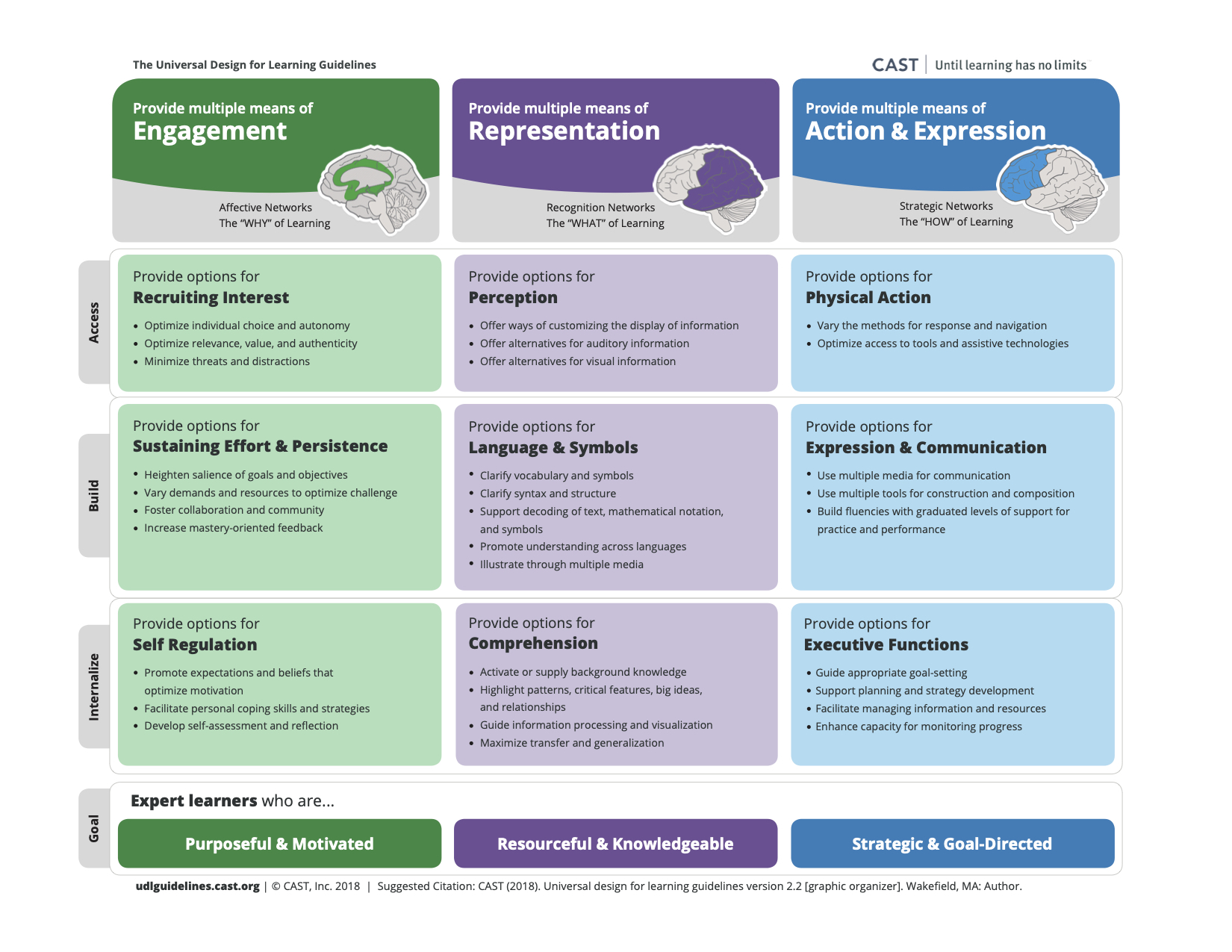Universal Design for Learning
Universal design for learning (UDL) is an approach to designing course instruction, materials, and content so that all students are able to access learning with a diminished need for retrofitting or accommodation. The concepts behind UDL encourage instructors to create flexibility and choice in their courses to the maximum extent possible so that unintended barriers to learning can be avoided or diminished.
Watch a brief video on UDL in Higher Education by the Center for Applied Special Technology (CAST), whose researchers developed UDL.
UDL Principles
The three research-based principles of UDL provide a framework for optimizing learning for all students.
1. Multiple Means of Engagement
Provide options and a variety of ways for students to interact with the course content, their classmates, and you, as the instructor. Allow students to make choices in as many aspects of the course as possible, thus building their autonomy and self-determination.
2. Multiple Means of Representation
Present content in different formats and allow students to choose the formats in which they learn best. Provide text options when audio is used and audio or text options where visuals are used. This allows students to gain access to content via the methods most accessible to them.
3. Multiple Means of Action & Expression
Create different ways for students to demonstrate understanding. Certain types of assessments can create barriers for some learners. Providing choice helps them avoid those barriers and better demonstrate what they know. Also, offer different ways for students to communicate and participate during class.
Universal Design for Learning Guidelines
Visit the CAST website for an accessible, interactive version of these guidelines.
UDL Strategies
During Instruction
- Use more than one method for presenting information. If teaching in a traditional lecture format, include slides or other visuals to support any auditory instruction. If using a visual diagram to demonstrate a concept, also include a written or audio description.
- Post or email slides in advance of each class. This allows students to focus the auditory content and discussion in class, rather than trying to copy down information from a slide.
- Vary the pacing of lessons. Keep lessons moving but allow time for individual and group interaction with the content.
- Share notes. Ask a student to share a copy of their notes with the class or consider having students crowdsource notes on a shared Google document. This is a great way to help students learn collaboratively and clear up misunderstandings in real time.
- Record your lectures and post the videos to Blackboard. This allows students to return to the lecture to clarify misunderstandings or missed content.
- Provide concrete examples and applications. Don’t assume that students are able to generalize the content – show them how it’s done. Connecting content to real-life, concrete examples helps to build understandings and transfer of skills.
When Establishing Course Policies
- Determine what is essential. Be purposeful when creating learning objectives and course standards. This will help you identify areas in which flexibility may be possible. Make sure these objectives are clearly stated for students.
- Make expectations clear. Provide students with detailed instructions and expectations for all components of your course, including assignments, participation, and grading.
- Build in flexibility with deadlines. Flares of disability conditions, life events, and access to resources can impact a student’s ability to complete their work. Building in a reasonable degree of flexibility with deadlines helps to prevent students from being penalized for circumstances outside of their control.
- Consider how attendance requirements align with course objectives. Are students able to complete the learning in the course without attending each class? If so, relax your attendance standards. If much of the earning is completed in class and attendance is, therefore, necessary, make sure this is made clear to your students.
When Designing Assessments
- Provide frequent, personalized feedback. This allows students to better gauge their understandings of the content and better direct their learning.
- Eliminate timed assessments. Time limits can create barriers for many students, including many students with disabilities and students for whom English is not their first language.
- Provide choices for assessments. Allowing students options (eg., paper or presentation; exam or project) for demonstrating their understandings helps to remove barriers that are created by certain types of assessments.
- Use a variety of types of questions on exams. If exams are still your best option for assessment, vary the types of questions used. Students may run into barriers with certain formats (eg., multiple choice or true/false), so providing a variety can help with demonstrating where students are actually struggling with the content vs. struggling with the question format.
Feeling overwhelmed with UDL?
Start with the +one strategy. Choose one topic or area where your students seem to struggle. Either
- Add ONE new way to present the content (add a video, a visual, a website, etc.)
OR - Add ONE new activity for students to complete (discussion, group project, quiz, etc.)
OR - Add ONE new way to assess understanding (paper, project, presentation, etc.)
When you’ve added this one new option to your course and feel comfortable with it, pick another area and use the +one strategy. It takes time to create a universally designed course. It doesn’t need to be done overnight.
Additional Resources on UDL
- UDL on Campus: A guide from CAST, developers of the UDL framework
- DO-IT's Center for Universal Design in Education: Resources from the University of Washington

